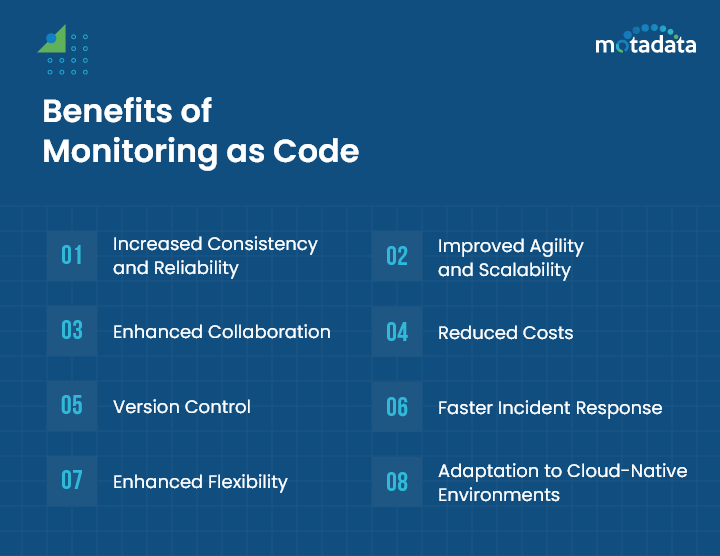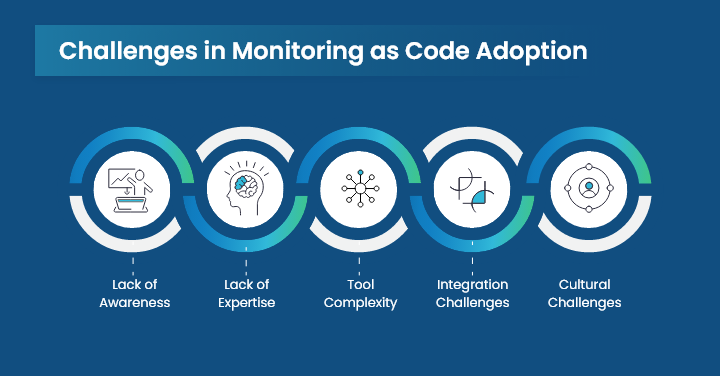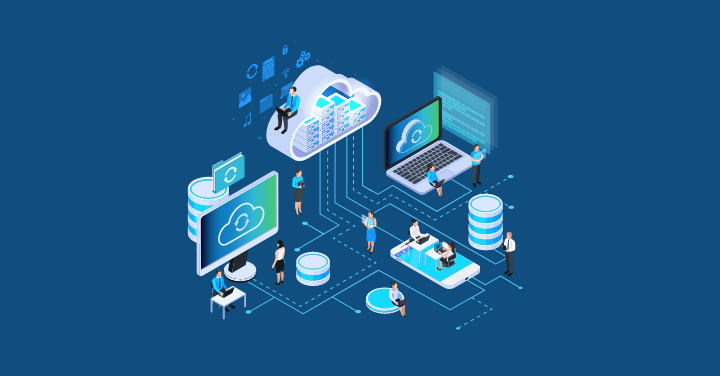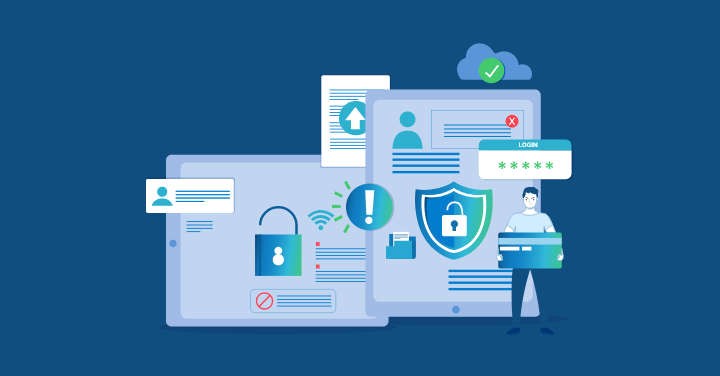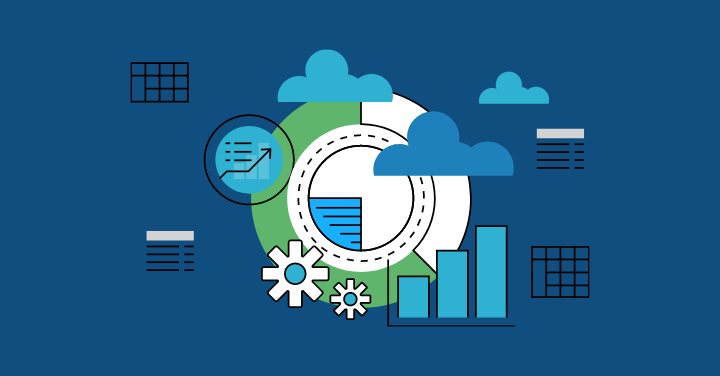Everywhere businesses are growing and adapting new technologies to stand out from their competitors. In fact, 91% of companies are working on a digital initiative as per a report by Gartner.
It has also been concluded that 89% of all businesses either already have a digital-first business strategy in place or intend to implement one.
With everything on the cloud and complex form, detecting issues can be quite challenging. Hence, in this ever-evolving landscape, it has become crucial for each business to rely on a monitoring solution that tracks down their issues in real-time and minimizes downtime.
Traditional monitoring practices will no longer be able to meet the dynamic nature of modern infrastructure. This is where the revolutionary Monitoring as Code (MaC) approach to system monitoring and management will come into play.
Before we proceed, let us learn about Monitoring as Code (MaC) in detail, including its significance, challenges, and best practices.
What is Monitoring as Code (MaC)?
Monitoring as Code is a modern technique that helps businesses to build react native apps, test and monitor sites and applications with API and browser checks. It provides end-to-end visibility across all resources and enables continuous tracking at all stages of the workflow.
It even treats configuration management and monitoring as code to automate all processes and improve the security of your apps and infrastructure. Basically, software development companies and DevOps can make the most out of this modern concept in the long run.
Why is Monitoring as Code Needed?
Monitoring as code has become the need of the hour as businesses are moving towards DevOps practices and a traditional approach is not enough to track issues.
This modern approach provides complete visibility and observability lifecycle, incident management, and automated processes, permits version control for effortless rollbacks, and incorporates monitoring as code for infrastructure.
How Does Monitoring as Code Work?
Monitoring as Code works quite similarly to the way IaC manages and monitors all the components of an infrastructure. It collects data for business-critical key performance indicators (KPIs) to make better decisions and strategies for product managers, software developers and Vision Pro developers.
MaC makes it easier for developers to establish and maintain strict version controls for their product as it develops by codifying all the monitoring processes. As a result, even a minor change in the code can be instantly tracked using the metrics.
Be it sending instant alerts, diagnosis, or troubleshooting everything can be done by creating automation scripts. In simple terms, MaC provides application developers and ITOps the ability to track and view how apps operate in real-time, quickly, as if they were built-in features.
Benefits of Monitoring as Code
1. Increased Consistency and Reliability
By leveraging monitoring as code, developers can constantly perform monitoring practices across different infrastructure and application components, test and deploy that help reduce the chances of errors, enhancing the overall stability of IT operations.
2. Improved Agility and Scalability
MaC provides complete control over automation that helps businesses scale seamlessly. It enables organizations to streamline the process and reduce time and effort by automatically provisioning. As a result, even if your team grows or expands, you will not face any issues in scaling resources.
3. Enhanced Collaboration
MaC makes it possible for team members to be more transparent by giving them more source control. It treats monitoring configurations as code that helps developers rollback more quickly and easily. It even enables team members to work together on application codes within the same repository and troubleshoot issues.
4. Reduced Costs
Adopting automation and removing manual configuration management and interventions helps businesses save on costs. The complete cost of setting up, management, and deployment is also eliminated.
5. Version Control
In the traditional monitoring approach tracking, tracking changes, and version control was quite challenging. However, with MaC, you can access superior version control and synchronize with development, testing, and deployment resulting in better visibility and quick tracking.
6. Faster Incident Response
The automated monitoring feature helps organizations easily troubleshoot and respond to incidents faster. It even supports integrating alerting systems that notify issues in real-time and reduce the overall incident resolution time and downtime.
7. Enhanced Flexibility
With MaC, organizations can quickly adapt to new technologies, and keep track of all processes as there is a change in the infrastructure component and environment. It even supports seamless integration with CI/CD workflows.
8. Adaptation to Cloud-Native Environments
MaC works well even for Cloud-Native Environments, thus allowing businesses and software developers to track down all dynamic and temporary resources efficiently. It even provides observability for cloud deployments and tracing code changes.
Challenges in Monitoring as Code Adoption
Traditional monitoring comes with various challenges and so does MaC. Let’s have a look at the challenges that organizations might have to deal with MaC.
1. Lack of Awareness
Monitoring as Code comes with various features and benefits that teams at times miss out on due to lack of awareness. This could be a challenge in the long run as the teams might lose out on enhanced visibility and automation possibilities as a result of unawareness.
2. Lack of Expertise
Another challenge that organizations might face with monitoring as code is it demands good knowledge and expertise. To properly implement this modern approach, many teams, however, lack the requisite expertise.
3. Tool Complexity
Monitoring as code tools demands knowledge and time for learning and setup. This can as a result discourage team members from implementing and embracing modern practices.
Additionally, to select and configure the right tool, organizations must be familiar with the features and their functionalities which can be another challenge.
4. Integration Challenges
It is essential for organizational team members to have proper knowledge of how to carefully execute the integration of MaC with existing IT processes and tools. Without comprehensive documentation and best practices, integration may pose challenges.
5. Cultural Challenges
Adopting a new practice for infrastructure monitoring is crucial but at the same time a bit challenging. Your progress can be hampered by reluctance, lack of cooperation, and resistance to change.
Solutions to Challenges in Monitoring as Code Adoption
Here are a few solutions to the above-listed challenges that will keep your business running smoothly.
1. Increase Awareness
To increase awareness about the new practice among the team members, best is to educate them by running workshops and training sessions. Share some of the use cases of monitoring as code adoption and documentation updating about the features and functionalities.
2. Build Expertise
The best way to overcome this challenge is to make your team members gain the skills and expertise in the fields with a proper training program. Let them collaborate and communicate with experts who can offer the right guidance and support for successful monitoring.
3. Choosing the Right Monitoring Tool
It is correct that you must have knowledge of the available options when selecting the right tool, so run thorough research before making a purchase. Go through all its capabilities and check if it will your organizational needs in the long run.
4. Integrate with other Tools
To ensure a smooth transition to MaC, it is crucial that your MaC tool integrates well with other processes and automation tools. Also, it is an important tool to look into another aspect, i.e., support integration with source code repositories.
Best Practices for Implementing Monitoring as Code
Here are a few Monitoring as Code best practices that all organizations must implement to achieve success and improve overall performance.
1. Define Clear Objectives
To ensure successful implementation of Monitoring as Code, it is crucial to well-define all your goals and objectives. This involves outlining what you want to achieve, such as optimizing system performance and guaranteeing compliance.
Additionally, well-defined goals help prioritize tasks, allocate resources, and measure your targets. Additionally, evaluating the effectiveness of your approach becomes easier.
2. Collaborate Across DevOps and Other Teams
Fostering collaboration between IT operational teams, development teams, and other team members is essential. With proper collaboration, the teams can align with the monitoring strategies and achieve goals faster.
Additionally, each can share their knowledge and expertise to troubleshoot issues faster. Further, teams can together work and improve the monitoring procedure as well as build a more reliable monitoring system.
3. Start by Defining Your Monitoring Requirements
Define all your monitoring requirements and prioritize the KPIs and metrics that require prior attention. Go through all the logs and events that are crucial for business and play a vital role in delivering good performance.
You can even collaborate with other team members to gain insights into specific metrics. By knowing your monitoring requirements, you can look into areas that really affect the success of your company.
4. Send Your Monitoring Data to a Central Location
Another important task that organizations must perform is to aggregate all the monitoring data and information in a central location or dashboard for easy access and quick analysis.
The centralized dashboard will help IT operational teams store and access all the information from a single place and gain a holistic view of the overall performance. Hence, to implement an effective monitoring-as-code paradigm, organizations must send all monitoring data to a central place.
5. Create Alert and Notifications
Having an alert system with different notification channels is essential for successful monitoring. Configuring alerts will help you notify about detected anomalies and issues at the right time using various channels, such as email or messaging platforms, and keep the application in its best shape.
6. Automate Configuration Deployment
By leveraging automation tools, you can ensure that run an error-free monitoring setup and save on costs. Further, it will help save your time and effort by automatically provisioning and configuring all the components of your infrastructure.
Automation will not only put an end to manual errors but also help streamline the entire process of infrastructure changes.
7. Establish Coding Standards
By establishing coding standards for configuration monitoring, IT operations may operate more efficiently by ensuring best practices and consistency.
Adhering to coding standards facilitates debugging and understanding of monitoring code, hence accelerating incident response times. It even facilitates seamless plugin integrations and robust monitoring infrastructure.
8. Continuous Testing of Monitoring Configurations
With constant testing of your monitoring configurations, IT operational teams can identify and resolve configuration issues at a much initial stay. This will further help ensure reliability, accuracy, and improved efficiency.
9. Encourage Continuous Improvement
Performing analysis and constant monitoring of code changes will help improve overall performance and efficiency. Metrics are easily visible with monitoring as code, making it possible to spot areas that need work.
Monitoring procedures can be continuously improved with the use of code updates that are trackable and monitorable. More thorough measurements and observability are the result of these ongoing advancements.
10. Version Control
Management of configuration changes is made easy by version control, which keeps track of code changes. Organizations can quickly revert to earlier setups if needed by tracking and comparing monitoring code changes.
Additionally, version control of the monitoring code guarantees the repeatability of the configurations and makes troubleshooting more efficient.
11. Reporting
Monitoring as Code allows the creation of comprehensive reports and workbooks depending on the employee role and other aspects that can be later used for running audits.
The monitoring as code tools even supports integration with top reporting tools that help in data visualization and root cause analysis. Regularly viewing these insightful reports will help in the quick detection of issues and better-informed decisions.
Conclusion
Monitoring as Code is a revolutionary approach that helps businesses go beyond the traditional approach of monitoring and tracking down issues faster.
By considering monitoring configurations as code, organizations will be able to scale seamlessly, maintain consistency, and improve collaboration.
It might seem challenging in the initial stage but in the long run can be great for businesses and software development companies.
There are several benefits of monitoring as code for infrastructure but choosing the right tool like Motadata is fairly important for successful implementation.
Make sure to keep different factors in mind when selecting one for your business and adhere to the above-listed. By adhering to best practices for continuous smooth monitoring and operations.
FAQs
Unlike the traditional monitoring approach, monitoring as code is a more scalable, efficient, and agile solution. It supports the revolutionary approach that includes automation, version control, team collaboration, and more features that offer more reliability and efficiency.
Monitoring tools include an interface that allows for manual configuration which can be even performed by operational teams. The only problem is that it is a slow process and takes a lot of time.
However, with MaC, developers can quickly spin up and configure multiple monitors automatically. This means each time a new endpoint is established, a matching endpoint will be automatically created and ensure consistency. Thus, automating your monitoring operations will help you become more efficient.
Some of the essential components of a Monitoring as Code strategy that you must keep in mind include data collection, analysis, version control, continuous testing, and collaboration among team members.
The tools selected for monitoring must be capable of collecting data and comprehensive metrics from different sources including servers, applications, and network devices.
Further, they must include automation functionalities that will help ease the entire process. Additionally, a real-time alert option that will notify businesses about performance issues and potential problems at the same time.
You can easily find several Monitoring as Code tools online, but how to choose the right one that aligns with your organizational needs depends completely on several factors.
Check if the tool is scalable and can meet the increasing demands. Secondly, look if the code is capable enough to collect and track down all the metrics and data. Another important factor to keep in mind is the integration capabilities and customization options.



